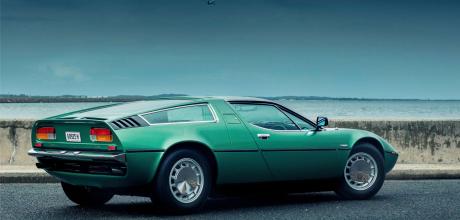1971 Maserati Bora
Maserati has not been the only automotive manufacturer to appropriate the names of winds for some of its cars, but the quartet of Maserati GTs from the 1960s and 1970s, were more deserving of the implication ‘goes like the wind’ than some others – the Lincoln and Ford Zephyrs, the Holden Camira and even the Volkswagen Scirocco (with its gratuitous additional ‘c’ after the capital S) all come to mind.
The 1963 Mistral (strong, cold north-westerly blowing from the Rhine Valley into the Mediterranean) built on the 3500 GT’s credentials, though lacking that car’s timeless grace. The 1966 Ghibli (hot, dry wind blowing across the Libyan desert) was in the same tradition, as was the 1972 Khamsin (another hot dry wind patrolling North Africa and the Arabian Peninsula). But the most interesting of Maserati’s like-the-wind models is the 1971 Bora (cold north wind, a breath of very fresh air if you like), a truly revolutionary supercar.
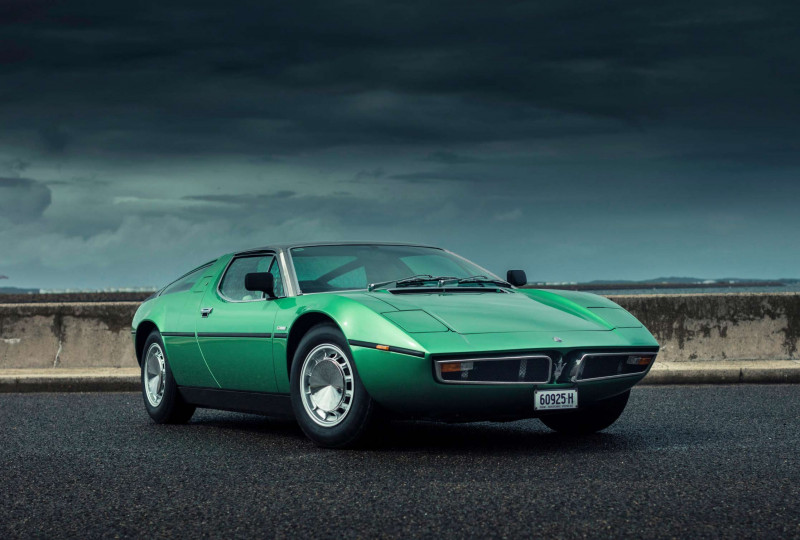
Before the Bora with its lissome Giorgio Guigaro bodywork, Maserati production cars had been conservative, sometime to the point of being outdated. The Bora was bracing in the rarefied world of Italian supercars (even though that term still awaited coinage). Here was the company’s first mid-engined model, half a decade after Lamborghini astonished the world with its Miura. This was also the first Maserati to feature all-independent suspension. Paradoxically, despite being owned by Citroën since 1968, this suspension was not that company’s trademark hydropneumatics arrangement but by coils all round with front and rear anti-roll bars. Nevertheless, the Bora did have a hydraulic pump and an accumulator just like a Diesse, which were used to power the steering, brakes, pop-up headlights, driver’s seat height and the pedal carriage. In many respects, the Bora was unique. Unlike any other Italian GT of the day it was quiet.
THE BORA WAS ALMOST CERTAINLY PRODUCED TO A SUPERIOR STANDARD THAN ANY OF ITS ITALIAN RIVALS
The V8 may have been only a short distance behind the fortunate occupants of a Bora, but the engine and the rear suspension were fixed to a tubular cradle joined to the front monocoque by damper blocks. The engine sat under a carpeted aluminium cap and the engine cover was double-glazed. In 1971! It was also rare among GTs in delivering braking commensurate with the performance.
Big vented discs were used at each corner. As anyone familiar with big Citroëns from the 1955 Diesse onwards, there is a superbly firm, short-travel brake pedal mediating an astonishingly powerful system. Citroën management wisely chose not to use the small trademark brake button but installed a conventional pedal. I mentioned the pedal carriage: the driver’s seat was fixed, while the pedals moved backward and forward and the steering wheel was telescopic. This was the first production car with a pedal box that slid in response to the push of a button – distance, zero to three inches in scant seconds.

(Maserati buyers who wanted a more Citroënesque experience could later choose the less expensive, less rapid Merak which shared its soon-to-be-notoriously complex V6 with the SM. Complex? Try timing chain adjustment every 5000 miles! Or, of course, they could choose an SM. It was almost certainly the Citroën connection that held Bora and Merak values relatively low for so many years, compared with comparable Ferraris.)
The Bora’s all-aluminium 4.7-litre V8 traced its lineage to the 450S racer. Its quad camshafts were chain-driven and there were four valves per cylinder. Maximum power was 239kW (320bhp) at 5500rpm (yellow line on the tachometer; the redline was at 6000) with 454Nm (335lb/ft) of torque at 4000. The 4.7 was joined by a stroked, higher torque 4.9. There was a quartet of 42 DCNF/14 downdraught Webers and Bosch electronic ignition. A five speed transaxle was used. Zero to 60 miles per hour took 6.3 seconds and the standing quarter-mile 14.5. (The Merak’s corresponding numbers were 10.6 and 16.5.) By 1971 standards, the Bora’s elegant 15-inch Campagnolo light alloy wheels were wide at 7.5 inches. Early cars boasted removable polished stainless steel hubcaps. Initially, tyres were Michelin XWX 205/70 all round. But the Bora displayed a tendency to ‘tramline’ and wider 215/70VRs were fitted at the rear with the choice between Michelin XWX and Pirelli Cinturato CN12.
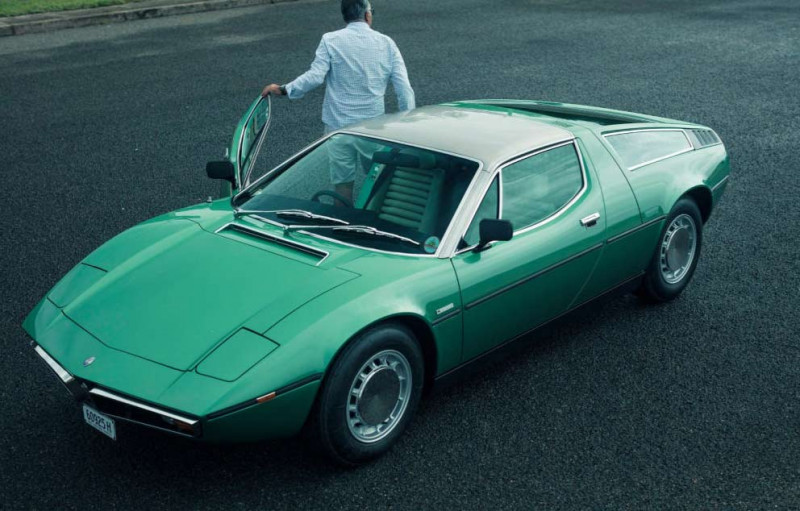
The roof and A-pillars are of brushed stainless steel. Leather adorns seats, dash, doors, centre console and the rear bulkhead. Fast glass and air-conditioning were standard equipment. Contemporary reviewers commented on the solid, high-quality feel of the Bora and it was almost certainly produced to a superior standard than any of its Italian rivals.
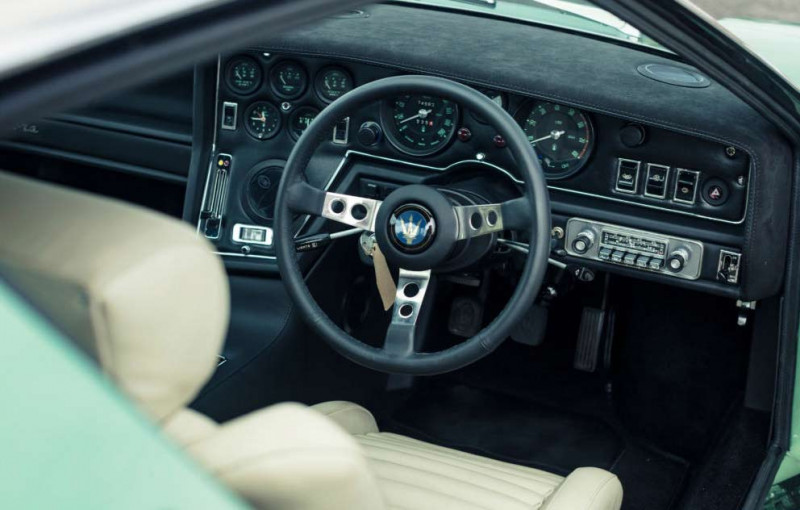
What a treasure of car, especially in Verde Indy like Greg Gialouris’s car shown here! Greg acquired it in December 2013 and from May or June of the following year until November 2018 it underwent the most painstaking ground-up restoration imaginable.
How Greg came to own his Bora is a tale in itself. At the time he had a contract to buy a brand new Audi R8 sitting on his desk. ‘I thought I’d let the salesman stew,’ he laughs. It was, he recalls, a rainy Saturday and he just started looking on the internet for a Bora. Amazingly, despite the fact there only ever four or five in Australia, he found this car. ‘When I saw it advertised, I went for it – it didn’t matter how bad it was, I just had to go for it. I got hold of the guy on the phone and did a deal on the spot. Then I went down to Melbourne and picked it up.’ So the Audi R8 never made it into Greg Gialouris’s collection.
FOR MANY YEARS MASERATIS WERE LITTLE MORE THAN HALF THE PRICE OF COMPARABLE FERRARIS
Like many of us, Greg had long loved Italian cars. He retired from the real estate business at 54 some 13 years back. ‘I grew up in country New South Wales,’ he says, ‘Lismore. My first car was a Fiat 124, not the coupe, the sedan.’ He chose well because the 124 was International Car of the Year in 1967, an utterly joyous little driver’s car (impossibly superior to, say, an HR Holden Special!). ‘Except the cable-operated clutch,’ says Greg. And the rust…
After the Fiat came Alfettas. But it would not be until 2001 that Greg proudly bought his first Maserati, a brand new 3200GT and that bracing Maserati breeze blew into his life. He now owns four Italian cars, of which the Bora is unquestionably his favourite.
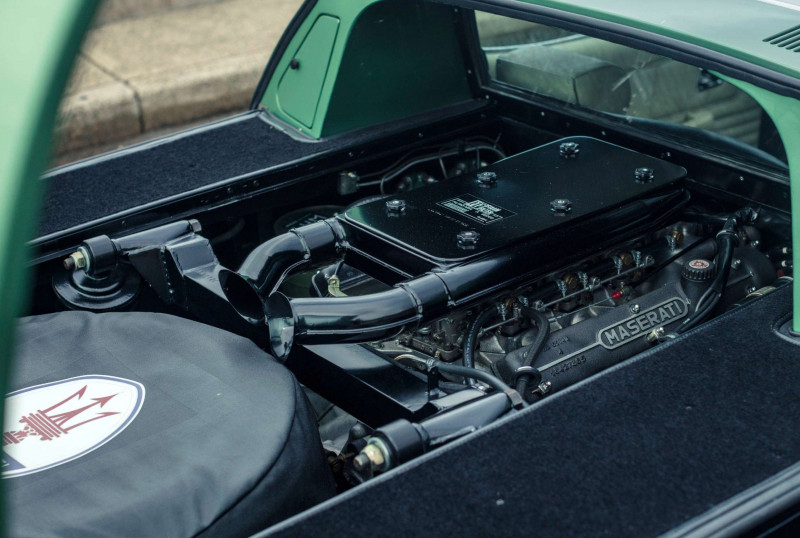
When Greg got his Bora, which had arrived from England in about 2009 – the model was never sold new here – like so many Ferraris and Maseratis it was finished in bright Italian racing red. From the beginning, he was dedicated to the task of returning it to its original state. This required much time spent on internet fora and talking to Maserati club members. ‘It wasn’t as if I could ring a mate and say, can I drop over and have a look at yours!’
I have seen different numbers quoted for total Bora production, but Greg’s 524 seems the most reliable. He thinks just 27 right-hand-drive cars emerged from Modena. This one is now in a far better condition than when it left the factory – for example, galvanised plate means rust will never again be an issue.
‘I was particular,’ he says, ‘but my restorer Race Motorbodies in Padstow (Sydney) was very particular. I helped with the work myself, including the sandblasting and sourcing all the parts that were available. Many had to be especially made. Michael Mitchell rebuilt the engine. Being involved in a hands-on fashion for all those years the restoration took has given Greg a profound sense of belonging with this Maserati.
‘Compare it with a Countach or a Mangusta,’ he says, ‘and it is obviously built better.’ The Bora is also enticingly rare.
For many years Maseratis were little more than half the price of comparable Ferraris, but more recently an increasing band of devotees have come to enjoy the unique positioning of the trident marque. This Bora, for example, is a more civilised cruiser with more space for occupants and their luggage than you would expect of a contemporaneous mid-engined Gran Turismo, doubtless reflecting Maserati’s lack of direct involvement in motorsport; great as so many Ferraris are, you only have to read Brock Yates’s celebrated biography of Enzo Ferrari to realise his lack of passionate interest in the road cars sold in his name and his contempt for his customers.
So it seems fair to suggest that Maserati, by the time the Bora was conceived under the new Citroën management, was focused on creating new models that would be user-friendly in everyday conditions. Although Greg Gialouris’s superb specimen will never be a daily driver, it has been exposed to the rain and you have the feeling that it would take kindly to regular journeys on the Hume Freeway or across the Snowy Mountains.
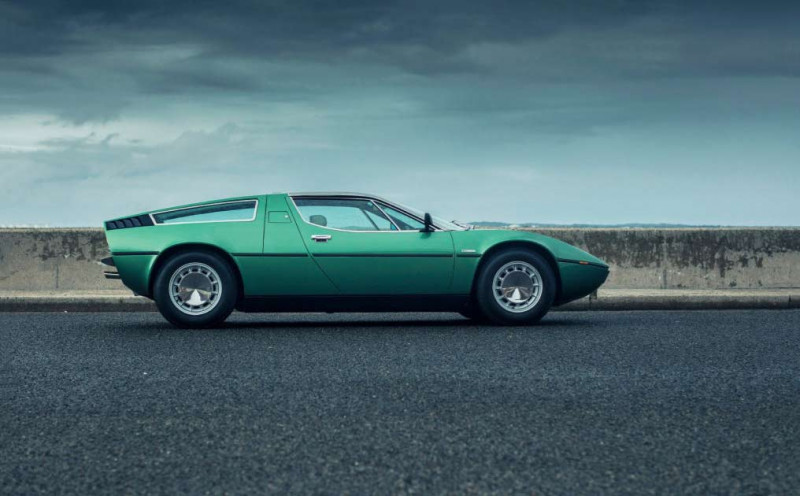
LEFT: Verde Indy with beige leather is surely one of the most subtle and delightful colour combinations.
LEFT: Build quality was superior to that of contemporaneous Italian supercars. There is wonderful texture in the details.
LEFT: traces its lineage back to the legendary 450S racer, so there’s plenty of Moss and Fangio as well as Citroën in the Bora.
BORA — COLD NORTH WIND, A BREATH OF VERY FRESH AIR IF YOU LIKE


